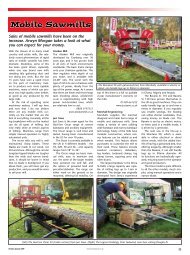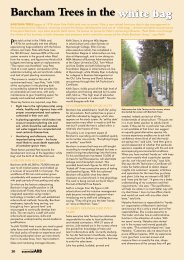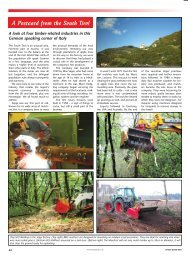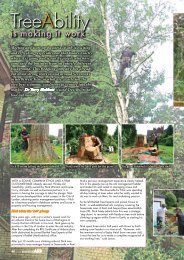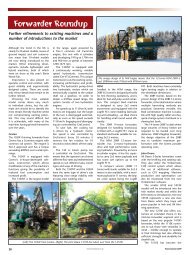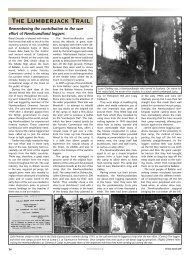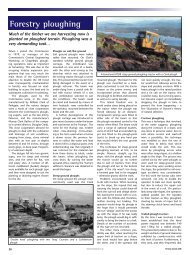Godington Estate - Forestry Journal
Godington Estate - Forestry Journal
Godington Estate - Forestry Journal
- No tags were found...
You also want an ePaper? Increase the reach of your titles
YUMPU automatically turns print PDFs into web optimized ePapers that Google loves.
GodintonBeing a self-governing estate,we can think long termThree miles from AshfordInternational in Kent, justbeyond the HS1 (Channel Tunnelrail link), a left turn opposite a oneyear-oldtract of coppice leads thevisitor through wrought-iron gatesand into the surprisingly tranquilgrounds of the 970-acre Godinton<strong>Estate</strong>. The drive sweeps throughparkland dotted with oaks, passingthe fenced-off Chestnut Tell plantation(once a cathedral grove ofgiants irrevocably damaged in the1987 storms), ending at a topiaryyew hedge surrounding a large,Jacobean-style building.The wider estate comprises threetenanted farms, two blocks of farmbuildings (let office units and workshops),a dozen let residentialproperties, 100 acres of woodlandand a small woodyard. At its heart,the Grade 1 listed Godinton House(open to the public three days aweek) and gardens (open everyafternoon) receive nearly 10,000visitors a year.Inside the house, the medievalhall, famous for its 16th-centurycarved wooden chimneypiece,wood panelling, and ceilingsecured by a 14th-century chestnuttie beam and crown post (a rarityin southern England), is quiet onthis chilly Thursday afternoon.Along a corridor, in the warm butempty tearoom, <strong>Estate</strong> ManagerNick Sandford is waiting. “Until150 years ago, this house wouldhave been heated entirely by woodcut on the estate. We have justcompleted a rather large circle, bygoing back to using the estate’ssweet chestnut woodlands as ourmain source of fuel.”graduate of the RoyalA Agricultural College,Cirencester, Nick (54) worked forthe National Trust as a land agent,managing a number of estatesbefore joining Godinton in 1997.Here, for the first time, he wasdirectly involved in managing allareas of an estate, from running ahouse open to the public, to being‘head forester’ directly responsiblefor parkland trees. These comprise40 acres of broadleaves, interspersedwith small blocks of conifer(unmanaged for 30 years), and 50acres of sweet chestnut coppice,just about under regular management.Nick’s first brush with biomasswas during his time at the NationalTrust, when he visited the WestDean <strong>Estate</strong>, which installed boilersin 1981. “At the time, oil was socheap, it [biomass] seemed to bean incredibly expensive way toheat a property. We [NationalTrust] could not work out the economicsof it. West Dean said thatthey were ahead of the game,recalling the spike in oil prices atthe end of the 1970s. I did like theidea of using the timber. Theirinstallation showed that it could bedone on a large scale, and it stayedin the back of my mind.”In his first years at Godinton, Nicksold cants of coppice, 0.25 to 1.5acres in size (four acres in total), tocoppice workers. He began tidyingthe conifer; thinning and convertingit back to broadleaf (oak, ash),replanting parkland oaks and plantingnew woodland strips.“When I came here, it wasbecoming increasingly difficult tofind people who would pay anythingbut a minimal sum to cutcoppice. In England, forestry waslacklustre. Markets were drying upand you could not make it pay. Wewere paid £200 an acre at best. Itseemed that we ought to be doingsomething else with the resource. Ipursued biomass out of frustration,really.”In 2002, Nick bought 30 acres ofland, including 10 acres of undermanagedcoppice, to replace thoseswallowed by the completion ofHS1. Two years later, the estateinvested in a speculative developmentat Worten Farm, convertingthree farm buildings into officeunits, all to be heated by biomass,with no backup systems.“Being a self-governing estate,we can be at the vanguard of ideasand technology and we can thinklong term. To have complete control(from timber source to heatconsumption) is beneficial. There isonly one person to blame if it goeswrong. At Worten Farm, we usedan old grain store to house theboiler. Econergy applied for a 25%grant [Blue Skies, now defunct] andinstalled a 45-kilowatt KWB boilerand chip store. They charged us forthe installation, less the grant. Weadvertised the units and found tenantsquickly. The boiler went live inOctober 2005, fuelled by timberfrom 0.5 acres of coppice cut byour estate staff.”Godinton’s 60 acres of coppiceis cut on a 15-year rotation. Oneacre of well-managed coppice canproduce 100 green tonnes of timber.Depending when in the year itis cut, chestnut loses between 20%and 30% moisture, leaving 75 to80 dry tonnes. “In theory, this boilerconsumes 30 tonnes of chip ayear. In practice, it uses 15 tonnes(possibly because of the highstandard of insulation that wasused in the conversion). We refillthe chip store with G30 chip onceevery two months during peakwinter usage.”Chestnut coppice has thin sapwood,thin bark, and burns well.What Nick did not factor into theequation is that any timber willburn in a biomass boiler. “I felledash and hornbeam in the park, andput it aside for firewood. We usedso little that we chipped it alongwith softwood thinnings and someropey old poplar, felled because itwas growing too fast in the wrongplace, and burned it all in the boiler.”In 2007, heating bills (oil) for themain house, two greenhousesand four cottages, were in excessNick Sandford with the Herz BioControl 3000 350kW boiler.<strong>Forestry</strong> <strong>Journal</strong> 9/12 www.forestryjournal.co.uk35
of £24,000. In 2008, with grant aidfrom South East Woodfuels, a feasibilitystudy (replacing the existingoil-fuelled boilers, burning oil at35p per litre, with a biomass installation)was carried out. The studyestimated that this second installationwould cost £250,000 (with40% of the cost covered by a grantfrom the RDPE) and pay for itselfover 10 years. “Taking into accountthe overall benefits as well as thefuel savings, Godinton Board ofTrustees commissioned a secondboiler in May 2009.”Fuel handling is key to the successof any biomass scheme.“Godinton is a Grade 1 listed propertyand retrofitting a new biomassboiler in an old oil-fired boilerroom is not easy. Ours are in thecellars and you cannot get woodfueldown there. Over the life of abiomass boiler, the fuel is 80% ofthe total running costs. Getting acheap and efficient fuel deliverysystem up front, with enoughspace to deliver the fuel over thelife of the wood-fired boiler (30years), pays off. It makes sense tomove heat via an insulated heatmain rather than to have costly fueldeliveries. We were fortunate tohave a redundant farm building(8m x 16m) at the back of thewalled garden.”Rural Energy installed a HerzBioControl 3000 350kW boiler,a 15,000 litre buffer tank, a fuelhandling system (sweep arm/augerof 4.5 metres) in the 60-tonne fuelstore. Two separate (and buried)pre-insulated heating mains carryhot water to the greenhouses (a20-metre pipe run) and intoGodinton House (120-metre piperun).Godinton House is filled withancient panelling, furniture andpaintings. The rooms are controlledby ten zone controllers, keeping asteady relative humidity of 50 to65%. “This system was advancedwhen installed in 1998 and thesensors should have informed thebiomass boiler controls when heatwas required. While the system stillworks, the integration of the newboiler has raised problems of obsolescence.The Trust has decided toupgrade the control system laterthis year.”Going live in May 2009, therewere some plumbing issues. Nickstresses that they were not issueswith the boiler itself. “Boilers aresophisticated machines; they maygrumble, but they do generallykeep working. The oil-fired boilerswere left in situ; the cost of decommissioningthem was ridiculous.They did provide a useful backup,once, during a power failure in theboiler room.”Both boilers require routinemaintenance, and estate workerBarry Holmes is the man responsible.The Herz boiler consumes 250tonnes of chip a year, burning atonne a day in the winter. Whenrefilling the chip store every 50days, he empties the ash and performsroutine checks on the controlpanel.Nick continues, “The only realdrawback of having two differentmakes of boiler is that we have tocall out two different service engineers(KWB once a year/Herz twicea year), which is expensive.Currently, servicing is a bit of aclosed shop and rather like taking aPeugeot to a BMW garage. Eventhough the mechanics are thesame, there are small differencesand BMW will not fix a Peugeot.”The final cost of the secondinstallation was £300,000, and thegrant only 23%, re-projected topay for itself over 12 to 15 years.Tim Hollingsbee’s Lokomo 910 extracting coppice.Had it been commissioned twomonths later, Nick would havequalified for the Renewable HeatIncentive (RHI subsidy of 5 penceper kilowatt of heat produced). “Icalculated that we would be gettingat least £25,000 a year underthe RHI for this boiler. I missed outon it by two months. Tragic.”Nick is now a woodfuel expert.“When I first started, Ichecked wood with a moisturemeter. Now I can look at a stackand know if it is ready for chipping.We used to season timber in thewood, grabbing it when needed.During our first year of running the350kW boiler, I had to buy in oneload of chip [from Torry Hill].Although I had enough wood, theweather was appalling and wecould not reach it. We could nothave chipped it because our con-tractor was snowed in.”In 2010, a one-acre ‘stack yard’(woodyard) with a hard-standingsurface was created at SwinfordBuildings, an old cattle yard. Cuttimber is stacked to dry in orderlyrows spaced wide enough to allowa chip and trailer to work side byside, chipping down the line. “Thechipper I hire chips up to 70tonnes a day, so I converted anopen-sided hay barn using chestnutpoles for cladding to store 50tonnes of chip. Because of the mildwinter I now have an enormousstack of wood [400 tonnes], but itwill not go to waste.”Fencing panels (right), made from Godinton chestnut, will be used in thegardens.Chipping fuel with a Heizohack, brought in by South East Wood Fuels.36www.forestryjournal.co.uk<strong>Forestry</strong> <strong>Journal</strong> 9/12
Since Nick came to Godinton, they have planted 400 parkland trees, a oneacrewillow bed for water polishing (a final treatment for agricultural waterbefore it goes back into the river) and five acres of new woodland like thisstrip, a mixed plantation of field maple, silver birch, hazel, beech, ash andcherry, with oak. The plan is to coppice all the trees, leaving a final crop ofoaks. Squirrels have enjoyed the field maple – they like the sweet sap. “Wedo tend to treat maples and sycamore as sacrifice trees; they don’t matterso much. Hopefully the squirrels will leave the oaks alone.”Nick sitting on a shave horse used on courses run by a tenant, craftsmanAlan Sage. A shave horse is a traditional coppice worker’s vice for workinggreen wood. Nick uses his feet to grip the vice and demonstrates smoothinga piece of wood (without a draw-knife).In addition to the ecologicalbenefits, Godinton’s well managedcoppice creates new timber opportunitiesfor the estate. “We areextending the rotation to 20 years.Chestnut puts on volume in thelast 3 years of growth, but theamount of cutting remains same. Ibuy in undermanaged neighbouringwoodland to work while wedelay ours [currently at year 17].Cutting larger poles gives us asmall amount of marketable timber.As well as using chestnut fencingacross the estate, I have sold 20tonnes of Sussex fencing rails thisyear.“Cutting four acres of coppice ayear gives our contractor, TimHollingsbee, a certain amount ofwork. He rents a yard from us andruns his own firewood business. Hehas a big forwarder; we have asmall crane trailer. He works withBarry to bring the fuel from thewoodland to the yard.”Godinton no longer pays to heatthe main house and tenants arecharged an average of 6p per kilowatt-hourfor heat. Nick estimateshe could sell 50 to 60 tonnes ofchip a year from the estate. Theirfirst chip customer (a house andgardens on the Kent/Sussex border)has just ordered 30 cubicmetres.Once a ‘biomass champion’(2006–2008) for SEEDA (South EastEngland Development Agency,now defunct), Nick has sinceshown Godinton’s installations toover 300 people, includingBusiness Link members, farmers’groups, architects’ groups, surveyorsand county councillors; and stillthey come.“Burning our oldest fuel in amodern and efficient way bringshuge benefits to the woodlandsand to the local economy. I canmanage the woodlands and get anincome stream from them. I neverhave a problem disposing of lowvaluewood and I can sell qualitytimber if I have any. I sold a standard(dying oak amid the coppice)for £300 that was felled as wewent through. We make savings onfossil fuels, and there is a certain‘feel-good’ factor in producing sustainablefuel from a sustainablewoodland estate. Occasionally Ihear of someone that has investedin their own. I want to encouragemore people to do it, because itdoes work.”www.godinton-house-gardens.co.ukCarolyne LocherPlanting the willow bed in 2005.Fuelwood – woodfuel – Fuelwood – woodfuel – Fuelwood - woodfuelSami 440Come and see themachines workingat ClaywoodSplittaKindling &Logsfrom onemachine!- Sawbenches- Firewood machines- PTO & Self Powered- Towable versionsNew SamiAuto chopperFully AutomaticFirewood MachineTransaw 350 XLLog Splitters- 8 ton to 38 ton- various power optionsWood Fuel DrumChippersClaywood, Beausale, Warwick, CV35 7NX - Tel: 01926 484673e-mail:- sales@fuelwood.co.ukweb:- www.fuelwood.co.uk<strong>Forestry</strong> <strong>Journal</strong> 9/12 www.forestryjournal.co.uk37



